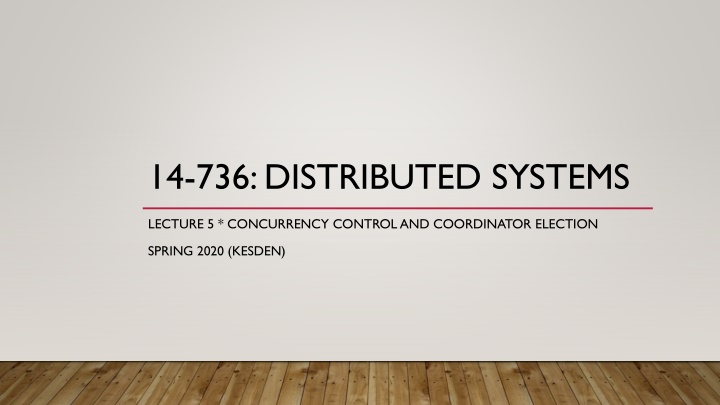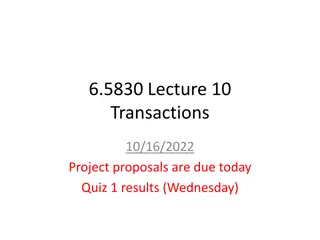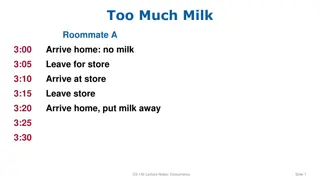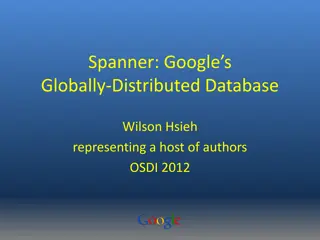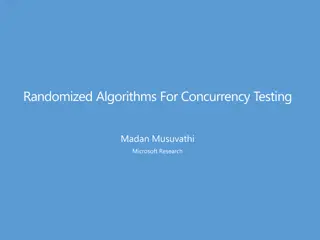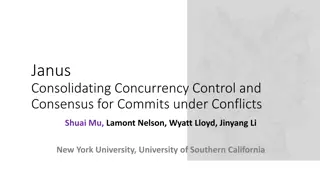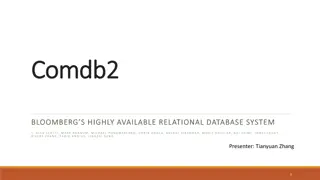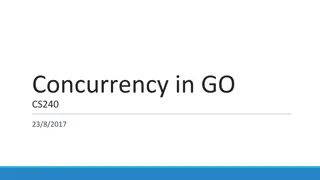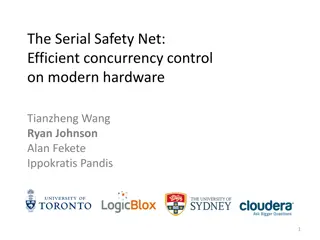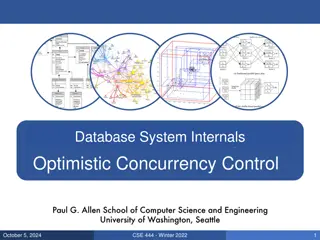Concurrency Control and Coordinator Election in Distributed Systems
This content delves into the key concepts of concurrency control and coordinator election in distributed systems. It covers classical concurrency control mechanisms like Semaphores, Mutexes, and Monitors, and explores the challenges and goals of distributed mutual exclusion. Various approaches such as the central approach and Lamport mutual exclusion are discussed, highlighting the trade-offs and considerations in designing efficient and reliable distributed systems.
Download Presentation

Please find below an Image/Link to download the presentation.
The content on the website is provided AS IS for your information and personal use only. It may not be sold, licensed, or shared on other websites without obtaining consent from the author.If you encounter any issues during the download, it is possible that the publisher has removed the file from their server.
You are allowed to download the files provided on this website for personal or commercial use, subject to the condition that they are used lawfully. All files are the property of their respective owners.
The content on the website is provided AS IS for your information and personal use only. It may not be sold, licensed, or shared on other websites without obtaining consent from the author.
E N D
Presentation Transcript
14-736: DISTRIBUTED SYSTEMS LECTURE 5 * CONCURRENCY CONTROL AND COORDINATOR ELECTION SPRING 2020 (KESDEN)
CLASSICAL CONCURRENCY CONTROL Semaphores, Mutexes, ConditionVariables, Monitors, etc. Requirement: Efficient, shared, consistent, memory Do we have that in distributed systems? Why or why not?
DISTRIBUTED MUTUAL EXCLUSION: REQUIREMENTS Correct: At most one user Progress: If the resource is available and a participant wants it, it can be put to use. Some level of fairness FCFS vs. tightly bounded wait vs eventual Must assume processes hold lock for bounded or non-infinite time. Fairness guarantees implies deadlock free
DISTRIBUTED MUTUAL EXCLUSION: ADDITIONAL GOALS Lets participants join and leave Tolerates failure Low message overhead Tolerates communications anomalies Loss, Delay, Reordering Obviously can t work with total failure
CENTRAL APPROACH Single coordination server maintains a local queue Participant: REQUEST message Coordinator: GRANT message Participant: RELEASE message 6 Messages per access, regardless of number of hosts. Note: All messages are ACKed, so 2x the 3 messages Simple, effective
CENTRAL APPROACH Single point of failure Can use primary-backup arrangement, but it isn t necessarily easy. Example: backup gets all requests, but only primary replies. backup takes over if primary fails heartbeat. But, what happens if there is a partitioning? What happens if server reboots?
LAMPORT MUTUAL EXCLUSION Big Idea Maintain a distributed queue, with a copy at each participant When done with critical section send RELEASE messages to each and every participant Each participant pops queue and new head gets to go New head sees for itself that it is at the head of the queue Trick: How to keep the queues in sync given that the messages can cross and arrive at different hosts in different orders?
LAMPORT MUTUAL EXCLUSION Assumption: Messages between pairs of hosts are delivered in order Such as via TCP Messages bear Lamport time stamps Queue is ordered by Lamport time stamps Total ordering, such as by hostID Requestor can t enter critical section until: It s own request is at the head of its own queue It s request is acknowledged by each and every host. Key point: The ACK will have a timestamp from the sender greater than the time at which the request was sent. Since requests are in-order between pairs of hosts, this means that the requestor has seen any prior request from the ACKing host, so its queue is correctly ordered in this respect.
LAMPORT PERFORMANCE 3(N-1) messages (Request, ACK, Release) No need to send to self, hence minus 1 Robustness? What happens if any 1 of N hosts fail? Ouch! Communication problems? Missing? Usual: No release? Ouch. No Request? Ouch. No reply? Ouch Reordered? Okay, except if within sender-receiver pair Upshot: Better rely upon TCP, etc.
RICARTIAND AGRAWALA In may ways inspired by Lamport Key observation: Reply and Grant can be combined by delaying reply until it is okay to use the critical section Reply effectively means Okay with me
RICARTIAND AGRAWALA Requestor (Request) Send REQUEST to each and every participant Participant If in CS, enqueue request If not in CS and don't want in, reply OK and want into the CS,and the requestor's time is lower, reply OK (messages crossed, requestor was first) and want into the CS,and the requestor's time is greater, enqueue request (messages crossed, participant was first) Requestor (Release) On exit from CS, reply OK to everyone on queue (and dequeue each) Requestor (When to enter critical section? Once received OK from everyone, enter CS
RICARTIAND AGRAWALA PERFORMANCE 2(N-1) messages ) = (N-1)(REQUEST + RELEASE) + OK No need to send to self, hence minus 1 Robustness? What happens if any 1 of N hosts fail? Ouch! Communication problems? Missing? Usual: No release? Ouch. No Request? Ouch. No reply? Ouch Reordered? OK Upshot: Better rely upon TCP, etc.
MAJORITY VOTING When entry into the critical section is desired: Ask permission from all other participants via a multicast, broadcast, or collection of individual messages Wait until more than 50% respond "OK" Enter the critical section When a request from another participant to enter the critical section is received: If you haven't already voted, vote "OK." Otherwise enqueue the request. When a participant exits the critical section: It sends RELEASE to those participants that voted for it. When a participant receives RELEASE from the elected host: It dequeues the next request (if any) and votes for it with an "OK."
MAJORITY VOTING: TIES (UT-OH!) Imagine M concurrent requests, each getting exactly N/M votes. We re stuck! To get unstuck, we use Lamport ordering w/hostID tie-breaking and favor earlier requests If a host gets an earlier request after voting for a later one, it asks for its vote back (INQUIRE) If the host to which it gave its vote is in the critical section No fault, no foul. Things happen out of order, but no deadlock is possible as progress was made: DENY If the host to which it gave its vote is not in the critical section Deadlock is possible: RELINQUISH The tie will now be broken in favor of lower ID host (and, even if not tied, no problem)
MAJORITY VOTING PERFORMANCE 3(N-1) messages (Request, OK, RELEASE) No need to send to self, hence minus 1 PLUS: Up to 2(N-1) INQUIRE-RELINQUISH Robustness? What happens if any hosts fail? <50% okay. Communication problems? Missing? Usual: No release? Ouch. No Request? Ouch. No reply? Ouch Upshot: Better rely upon TCP, etc.
VOTING DISTRICTS What we need is a way to reduce the number of hosts involved in making decisions. This way, fewer hosts need to vote, and fewer hosts need to reorganize their votes in the event of a misvote. In order to address to reduce the number of messages required to win an election we are going to organize the participating systems into voting districts called coteries (pronounced, "koh-tarz" or "koh-tErz"), such that winning an election within a single district implies winning the election across all districts.
GERRYMANDERING: A US HISTORY MOMENT! Gerrymandering is a term that was coined by Federalists in the Massachusetts election of 1812. Governor Elbridge Gerry, a Republican, won a very narrow victory over his Federalist rival in the election of 1810. In order to improve their party's chances in the election of 1812, he and his Republican conspirators in the legislator redrew the electoral districts in an attempt to concentrate much of the Federalist vote into very few districts, while creating narrow, but majority, Republican suport in the others.The resulting districts were very irregular in shape. One Federalist commented that one among the new districts looked like a salamander. Another among his cohorts corrected him and declared that it was, in fact, a "Gerrymander." The term Gerrymandering, used to describe the process of contriving political districts to affect the outcome of an election, was born. Incidentally, it didn't work and the Republicans lost the election. He was subsequently appointed as Vice- President of the U.S. He served in that role for two years. Since that time both federal law and judge- made law have made Gerrymandering illegal.
BACK TO VOTING DISTRICTS The method of Gerrymandering disticts that we'll study was developed by Maekawa and published in 1985. Using this method, processor's are organized into a grid. Each processor's voting district contains all processors on the same row as the processor and all processors on the same column. That is to say that the voting district of a particular processor are all of those systems that form a perpendicular cross through the processor within the grid. Given N nodes, (2*SQRT(n) 1) nodes will compose each voting district.
VOTING DISTRICT EXAMPLE Request: Send a REQUEST to each and every member of host s district Wait until each and every member of district votes YES (Unanimous YES) Enter the critical section Release Upon exit from the CS, send RELEASE to each and every member of host s district Received a REQUEST? If already voted in an outstanding election, enqueue the request. Otherwise send YES Receive a RELEASE? Dequeue oldest request from its queue, if any. Send a YES vote to this node, if any.
VOTING DISTRICTS: TIES Just as before Imagine M concurrent requests, each getting exactly N/M votes. We re stuck! To get unstuck, we use Lamport ordering w/hostID tie-breaking and favor earlier requests If a host gets an earlier request after voting for a later one, it asks for its vote back (INQUIRE) If the host to which it gave its vote is in the critical section No fault, no foul. Things happen out of order, but no deadlock is possible as progress was made: DENY If the host to which it gave its vote is not in the critical section Deadlock is possible: RELINQUISH The tie will now be broken in favor of lower ID host (and, even if not tied, no problem)
VOTING DISTRICT PERFORMANCE 3*(2*SQRT(N)-1) messages (Request, YES, RELEASE) No need to send to self, hence minus 1 PLUS: Up to (2*SQRT(N)-1) INQUIRE-RELINQUISH Robustness? What happens if any host fail? Intersecting districts can t get critical section. Ouch! Communication problems? Missing? Usual: No release? Ouch. No Request? Ouch. No reply? Ouch Upshot: Better rely upon TCP, etc.
TOKEN RING APPROACH Pass token around ring. Host with it has access to CS. High contention? 1 message/request Low contention? (N-1) messages/request
TOKEN RING: FAILURE Failed host or link to host Pass token to next logical node Failure within CS Minimally, no worse than any other situation With max CS time, can use timer to regenerate At time out, start ROSTER message around ring If sent ROSTER and receive ROSTER only propagate if from higher hostID. Highest host gets ROSTER will all hosts and generates new token Many regeneration messages can be sent. Can result in multiple tokens if partitioning Okay if can make parallel progress slower, or if only one partition can reach resources needed for progress Can require majority to generate token, preventing multiple (also possibly preventing regeneration)
RAYMONDS ALGORITHM Another way of approaching token-based mutual exclusion is to organize the hosts into a tree instead of a ring. This organization allows the token to travel from host-to-host, traversing far fewer unnecessary hosts. Raymond's algorithm is one such approach. It organizes all of the nodes into an unrooted n-ary tree. When the system is initialized, one node is given the token The other nodes are organized so that they form a tree. The edges of this tree are directional -- they must always point in the direction of the token.
RAYMONDS ALGORITHM EXAMPLE 7 Makes Request 1 Exits 2 Makes Request 6 Makes Request Initial 7 Exits 6 Exits
RAYMONDS ALGORITHM PERFORMANCE Obviously not robust to failure breaks path Worst case number of messages? Up and down, 2*log(N) Not FIFO/FCFS But, bounded wait May handle local request first, but then goes up before coming back down
PATH COMPRESSION (LI AND HUDAK) Originally developed to pass memory objects But, memory object can be a simple token Based on a queue of pending requests. The queue is maintained implicitly by two different types of edges among the nodes: Each node's current_dir edge leads to its best guess of the node that is at "the end of the line" of hosts waiting for access to the critical section. The node "at the end of the line" has this pointer set to itself. Current edges may be out of date. This is because a node may not be aware of the fact that additional nodes have been enqueued. But this is okay. A request can follow the current edge to the "old" end of the queue. This node will in turn lead to a node farther back in the list. Eventually, the request will come to the end of the list. Once a request reaches the end of the current edge chain, it will also be at the back of the queue maintained by the next pointers, so it can "get in line" and take its place at the end of the queue. The next edge is only valid for those nodes that either have the token or have requested the token. If there is a next edge from node A to node B, this indicates that node A will pass the token to node B, once it has exited the critical section. Nodes which have not requested the critical section, or have no requests enqueued after them, have a null next pointer. In this way, the next pointer forms the queue of requests. The next pointer from the token holder to the next node forms the head of the list. The next pointer from that point forward indicates the order in which the nodes that have made requests for the critical section will get the token. How do the current edges get updated? As a request is percolating through the nodes via the current edges, each node's current edge is adjusted to point to the requesting node. Why? Well the requesting node is the most recent request and is (or will soon be) at the end of the request queue.
PATH COMPRESSION (LI AND HUDAK) 3 releases token 6 releases token 6 requests token 2 requests token Start Fewer messages/request than Raymond s Still not robust to failure.
LEASES (GENERAL NOTE) Each approach has a problem: What happens if a client dies/walks-away/hogs a resource? Everything stops When possible it is most often preferable to Lease resources than to give them away Permission to use resource limited in time Not honored after that If needed longer, can request renewal Decision to renew may be nearly automatic (DHCP prefers to renew IP addresses to keep them stable) Or, it may be nearly automatic (Deny get back in line) Or, it may be based upon demand, etc.
COORDINATOR SELECTION: SELECTING A SPECIAL HOST Given N available hosts, where N isn t 1, how do we pick one for a different role, e.g. coordinator, front-end server, etc? Appoint one: A human simply picks Elect one: Participating hosts pick
APPOINTING A COORDINATOR A human, e.g. system administrator, picks from available hosts Advantages: Simple Minimal development time Agile Disadvantages Slow, i.e. human speed Requires human to detect failure, understand cause, determine participants, and react.
ELECTING A COORDINATOR The participants determine the need to pick a (new?) coordinator Participants discuss it among themselves Participants agree on coordinator New coordinator takes charge Advantages: Automatic Disadvantages Complexity (partitionings, etc) Network traffic (storms) Failure mode can be complex, e.g. many coordinators or none
Probably the most common BULLY APPROACH (GARCIA-MOLINA '82) Simplest Can lead to storms (We ll see why)
BULLY ALGORITHM Assumptions: All messages are delivered within some Tm units of time, called the message propagation time. Once a message is received, the reply will be dispatched within some Tp units of time, called the message handling time. Tp and Tm are known. These are nice, because together they imply that if a response is is not received within (2*Tm + Tp) units of time the process or connection has failed. But, of course, in the real world congestion, load, and the indeterminate nature of most networks mean that a good amount of slop needs to be included.
BULLY ALGORITHM The idea behind the Bully Algorithm is to elect the highest-numbered processor as the coordinator. If any host thinks that the coordinator has failed, it tries to elect itself by sending a message to the higher- numbered processors. If any of them answer it loses the election. At this point each of these processors will call an election and try to win themselves. If none of the higher-ups answer, the processor is the highest numbered processor, so it should be the coordinator. So it sends the lower level processors a message declaring itself the coordinator After they answer (or the ACK of a reliable protocol), it starts doing its job as coordinator E.g. It starts to query participants to find out what they know, then begins providing coordination, etc. If a new processor arrives, or recovers from a failure, it gets the state from the current coordinator and then calls an election Or, for efficiency, just remains a participant and lets the new coordinator lead, until it fails, etc.
INVITATION ALGORITHM: ASSUMPTIONS AND GOAL Goal: The Invitation Algorithm provides a protocol for forming groups of available participants within partitions, and then merging them into larger groups as partitions heal or failed coordinators are returned to service. In many ways, it is like a self-healing, partitionable Bully Algorithm Assumption: In practice communication failure, high latency, and/or congestion can partition a network. Assumption: A collection of participants under the direction of a coordinator, can perform useful work, even if other such groups exists. In other words, partitioned participants can still organize and make progress
INVITATION ALGORITHM: ASSUMPTIONS AND GOAL Groups are named using a group number. The group number is unique among all groups, is changed every time a new group is formed, and is never reused. To accomplish this, the group number might be a simple sequence number attached to the processor ID. The sequence number component can be incremented each time the processor becomes the coordinator of a new group. Basic idea: Partitioned participants (or whole group) elect their own coordinator Coordinators "yell out" periodically to participants outside their group asking each if it is a coordinator. When a coordinator answers, the coordinators pick one to coordinate, and merge their groups, electing a new coordinator Choosing the coordinator is Bully-like, with higher nodes winning.
INVITATION ALGORITHM: MERGING GROUPS One might think that it is acceptable for the coordinator that initiated the merge to be the coordinator of the new group. But it might be the case that two or more coordinators were concurrently looking for other coordinators and that their messages may arrive in different orders. To handle this situation, there should be some priority among the coordinators -- some method to determine which of the perhaps many coordinators should take over. One way of doing this might be to use the processor ID to act as a priority. Perhaps higher-numbered processors ignore queries from lower-level processors. This would allow lower-level processors to merge the groups with lower priority coordinators during this operation. At some later time the higher-level coordinators will each act to discover other coordinators and merge these lower-priority groups. Perhaps receiving the query will prompt the higher-level coordinator to try to merge its group with others sooner than it otherwise might. An alternative would be for a coordinator only to try to merge lower-level coordinators.
INVITATION ALGORITHM: OPTIONS Perhaps higher-numbered processors ignore queries from lower-level processors. This would allow lower-level processors to merge the groups with lower priority coordinators during this operation. At some later time the higher-level coordinators will each act to discover other coordinators and merge these lower-priority groups. Perhaps receiving the query will prompt the higher-level coordinator to try to merge its group with others sooner than it otherwise might. An alternative would be for a coordinator only to try to merge lower-level coordinators. Or perhaps processors delay some amount of time between the time that they look for other coordinators and the time that they start to merge these groups. This would allow time for a higher-priority coordinator to search for other coordinators (it knows that there is at least one) and ask them to merge into its group. If after such a delay, the old coordinator finds itself in a new group, it stops and accepts its new role as a participant. In this case, it might be useful to make the delay inversely proportional to one's priority. For example, there is no reason for the highest-priority processor to delay. But the lowest priority processor might want to delay for a long time.
RING ELECTION Another approach, Ring election, is very similar to token ring synchronization, except no token is used. Assumptions: We assume that each processor is logically ordered, perhaps by IP address, so that each processor knows its successor, and its successor's successor, and so on. Each processor must know the entire logical structure.
RING ELECTION When a processor discovers that the coordinator has died, it starts circulating an ELECTION message around the ring. Each node advances it in logical order, skipping failed nodes as necessary. Each node adds their node number to the list. Once this message has made its way all the way around the ring, the message which started it will see its own number in the list. It then considers the node with the highest number to be the coordinator, and this messages is circulated. Each receiving node does the same thing. Once this message has made its way around the ring, it is removed. If multiple nodes concurrently discover a failed coordinator, each will start an ELECTION. This isn't a problem, because each election will select the same coordinator. The extra messages are wasted overhead, while this isn't optimal, it isn't deadly, either.
